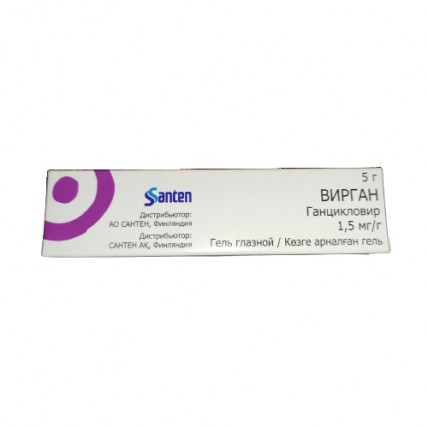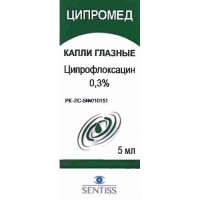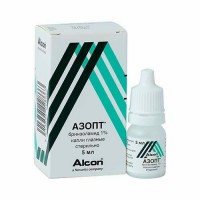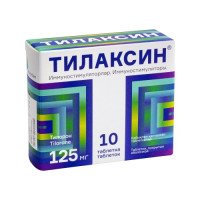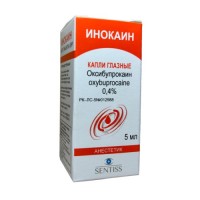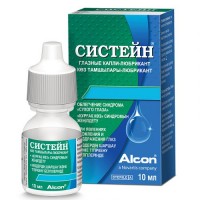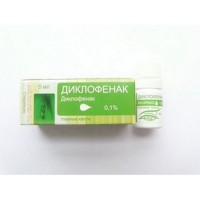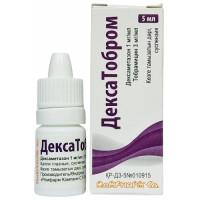Virgan® (Ganciclovir) Eye Gel 1.5 mg/g, 5 g Tube
- $55.50
Out Of Stock
Virgan® Eye Gel combines the power of ganciclovir, a broad-spectrum antiviral agent, with the comfort of a gel. It is indicated for the treatment of acute herpetic keratitis (dendritic and geographic ulcers)
Other Brand Names: Cytovene, Zirgan, Zyrgan, Cymevene, AI LIN WEI, Citovirax, Umecortil, Ganvirax, Ganguard, Vitrasert
The active ingredient is ganciclovir 0.15 % w/w. Each gram of gel contains 1.5 milligrams ganciclovir.
The other ingredients are benzalkonium chloride carbomer 974P, sorbitol, sodium hydroxide and purified water.
With ophthalmic use of the drug 5 times a day for 11 - 15 days in the treatment of superficial herpetic keratitis, plasma levels of ganciclovir are very low: an average of 0.013 μg / ml (0 = 0.037).
Ganciclovir quickly penetrates the cornea and anterior part of the eye; after a few hours, the concentration of the drug in the moisture of the anterior chamber exceeds the average effective dose (ED50).
Virgan - 9 -
guanine is a nucleoside that inhibits the replication of human Herpes viruses (Herpes simplex types I and II; cytomegalovirus) and adenoviruses of the following serotypes: 1, 2, 4, 6, 8, 10, 19, 22, 28.
In infected cells, Virgan is converted to ganciclovir triphosphate, the active form of the active substance.
Phosphorylation occurs mainly in infected cells, and the concentration of ganciclovir triphosphate in uninfected cells is 10 times lower.
The antiviral activity of ganciclovir triphosphate is to inhibit the synthesis of viral DNA by two mechanisms: competitive inhibition of viral DNA polymerase and direct incorporation into viral DNA with blocking of its elongation.
Indications for use
- acute superficial keratitis caused by the herpes simplex virus
To instill in the lower conjunctival sac of the affected eye 1 drop 5 times a day until complete re-epithelialization of the cornea, then 1 drop 3 times a day for 7 days.
The duration of treatment should not exceed 21 days.
Often (> 1/10)
- transient burning or tingling sensation in the eye
- irritation of the mucous membrane of the eye
- visual impairment
Less often (> 1/100, <1/10)
- superficial punctate keratitis
- conjunctival hyperemia
Do not use Virgan® Eye Gel: If the patient is allergic (hypersensitive) to ganciclovir or any of the other ingredients of Virgan® Eye Gel.
During pregnancy and breast-feeding, unless instructed otherwise by the doctor.
In men and women of childbearing age not using a method of birth control.
Moreover, men treated by Virgan® Eye Gel are advised to use a local method of contraception (such as a condom) for three months after the end of the treatment.
If the patient is using any other medicine to be applied in the eye, he should:
This drug is not intended to treat cytomegalovirus infection in the retina.
Effectiveness against keratoconjunctivitis caused by other types of viruses has not been established.
No special studies have been conducted in immunocompromised patients.
Due to the identified genotoxicity, men using Virgan eye gel are advised to use local contraceptive measures (condoms) during treatment and for three months after completion. For women of childbearing age, the use of contraception is necessary.
Benzalkonium chloride can cause eye irritation and discoloration of soft contact lenses. Do not allow the drug to come into contact with soft contact lenses. Remove contact lenses before using the drug, and reinstall them no earlier than 15 minutes after instillation.
Application in pediatrics
The drug is not recommended for use under the age of 18 due to lack of experience in use.
Pregnancy and lactation
There is not enough experience with the use of Virgan eye gel to assess its safety during pregnancy or lactation. Teratogenic effects on fertility have been observed in animal studies following oral and intravenous administration of ganciclovir. In addition, ganciclovir has shown genotoxic properties with a low margin of safety. In this regard, it is not recommended to use the drug during pregnancy or lactation, except for the absence of alternative treatments.
Features of influence on the ability to drive a vehicle and potentially dangerous mechanisms
The patient should refrain from driving or working with complex equipment in case of any visual impairment during treatment with the drug.
- Keep this medicine out of the sight and reach of children.
- Do not use this medicine after the expiry date which is stated on the tube and the carton after EXP. The expiry date refers to the last day of that month.
- Use within 28 days of first opening.
- Do not store above 25°C.
- Do not throw away any medicines via wastewater or household waste. Ask your pharmacist how to throw away medicines you no longer use. These measures will help protect the environment.
Shelf life - 3 years
The shelf life after the first opening of the tube is 4 weeks.
Do not use after the expiration date printed on the package.
Other Brand Names: Cytovene, Zirgan, Zyrgan, Cymevene, AI LIN WEI, Citovirax, Umecortil, Ganvirax, Ganguard, Vitrasert
Structure
The active ingredient is ganciclovir 0.15 % w/w. Each gram of gel contains 1.5 milligrams ganciclovir.
The other ingredients are benzalkonium chloride carbomer 974P, sorbitol, sodium hydroxide and purified water.
Pharmacological properties
Pharmacokinetics
With ophthalmic use of the drug 5 times a day for 11 - 15 days in the treatment of superficial herpetic keratitis, plasma levels of ganciclovir are very low: an average of 0.013 μg / ml (0 = 0.037).
Ganciclovir quickly penetrates the cornea and anterior part of the eye; after a few hours, the concentration of the drug in the moisture of the anterior chamber exceeds the average effective dose (ED50).
Pharmacodynamics
Virgan - 9 -
guanine is a nucleoside that inhibits the replication of human Herpes viruses (Herpes simplex types I and II; cytomegalovirus) and adenoviruses of the following serotypes: 1, 2, 4, 6, 8, 10, 19, 22, 28.
In infected cells, Virgan is converted to ganciclovir triphosphate, the active form of the active substance.
Phosphorylation occurs mainly in infected cells, and the concentration of ganciclovir triphosphate in uninfected cells is 10 times lower.
The antiviral activity of ganciclovir triphosphate is to inhibit the synthesis of viral DNA by two mechanisms: competitive inhibition of viral DNA polymerase and direct incorporation into viral DNA with blocking of its elongation.
Indications for use
- acute superficial keratitis caused by the herpes simplex virus
Method of administration and dosage
To instill in the lower conjunctival sac of the affected eye 1 drop 5 times a day until complete re-epithelialization of the cornea, then 1 drop 3 times a day for 7 days.
The duration of treatment should not exceed 21 days.
Possible Side Effects
Often (> 1/10)
- transient burning or tingling sensation in the eye
- irritation of the mucous membrane of the eye
- visual impairment
Less often (> 1/100, <1/10)
- superficial punctate keratitis
- conjunctival hyperemia
Contraindications
Do not use Virgan® Eye Gel: If the patient is allergic (hypersensitive) to ganciclovir or any of the other ingredients of Virgan® Eye Gel.
During pregnancy and breast-feeding, unless instructed otherwise by the doctor.
In men and women of childbearing age not using a method of birth control.
Moreover, men treated by Virgan® Eye Gel are advised to use a local method of contraception (such as a condom) for three months after the end of the treatment.
Drug interactions
If the patient is using any other medicine to be applied in the eye, he should:
- Apply the other ophthalmic medicine
- Wait for 15 minutes
- Apply Virgan® Eye Gel last
Special instructions
This drug is not intended to treat cytomegalovirus infection in the retina.
Effectiveness against keratoconjunctivitis caused by other types of viruses has not been established.
No special studies have been conducted in immunocompromised patients.
Due to the identified genotoxicity, men using Virgan eye gel are advised to use local contraceptive measures (condoms) during treatment and for three months after completion. For women of childbearing age, the use of contraception is necessary.
Benzalkonium chloride can cause eye irritation and discoloration of soft contact lenses. Do not allow the drug to come into contact with soft contact lenses. Remove contact lenses before using the drug, and reinstall them no earlier than 15 minutes after instillation.
Application in pediatrics
The drug is not recommended for use under the age of 18 due to lack of experience in use.
Pregnancy and lactation
There is not enough experience with the use of Virgan eye gel to assess its safety during pregnancy or lactation. Teratogenic effects on fertility have been observed in animal studies following oral and intravenous administration of ganciclovir. In addition, ganciclovir has shown genotoxic properties with a low margin of safety. In this regard, it is not recommended to use the drug during pregnancy or lactation, except for the absence of alternative treatments.
Features of influence on the ability to drive a vehicle and potentially dangerous mechanisms
The patient should refrain from driving or working with complex equipment in case of any visual impairment during treatment with the drug.
How to store Virgan Gel
- Keep this medicine out of the sight and reach of children.
- Do not use this medicine after the expiry date which is stated on the tube and the carton after EXP. The expiry date refers to the last day of that month.
- Use within 28 days of first opening.
- Do not store above 25°C.
- Do not throw away any medicines via wastewater or household waste. Ask your pharmacist how to throw away medicines you no longer use. These measures will help protect the environment.
Shelf life - 3 years
The shelf life after the first opening of the tube is 4 weeks.
Do not use after the expiration date printed on the package.
Scientific Studies
- https://pubmed.ncbi.nlm.nih.gov/9220235/
- https://pubmed.ncbi.nlm.nih.gov/24511226/
- https://pubmed.ncbi.nlm.nih.gov/20553233/
- https://pubmed.ncbi.nlm.nih.gov/19668521/
- https://pubmed.ncbi.nlm.nih.gov/25187721/
- https://pubmed.ncbi.nlm.nih.gov/22607463/
- https://pubmed.ncbi.nlm.nih.gov/29377953/
- https://pubmed.ncbi.nlm.nih.gov/27221265/
- https://en.wikipedia.org/wiki/Ganciclovir
